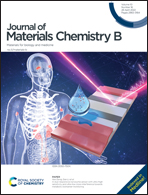A 3D-printed biphasic calcium phosphate scaffold loaded with platelet lysate/gelatin methacrylate to promote vascularization
Abstract
3D-printed biphasic calcium phosphate (BCP) scaffolds show great clinical application potential in bone tissue engineering; however, vascularization of the scaffold is a crucial step for bone regeneration and is still difficult to be controlled. To enhance scaffold vascularization, a novel bioactive scaffold loaded with platelet lysate/gelatin methacrylate (PL/GelMA) in a BCP scaffold was proposed for promoting vascularization. The PL/GelMA/BCP scaffold was successfully prepared via digital light processing (DLP) printing and filled with PL/GelMA to promote the vascularization effect. In vitro evaluation indicated that human umbilical vein endothelial cells (HUVECs) adhered well on the PL/GelMA/BCP scaffold, and cell proliferation was significantly promoted by coculture with the scaffold. Moreover, a variety of growth factors (GFs) in the PL were detected which were slowly released from the scaffold to modulate the cell behaviour and promote the formation of blood vessel-like structures. Co-culturing with the PL/GelMA/BCP scaffold upregulated the expression of angiogenesis-related genes in cells. In vitro results showed that a higher capillary formation was also observed in PL/GelMA/BCP scaffolds implanted subcutaneously on the back of the rats. These results indicated that the vascularization ability of BCP was enhanced by filling it with PL/GelMA. The PL/GelMA/BCP scaffold has the potential to promote vascularization in tissue engineering.



 Please wait while we load your content...
Please wait while we load your content...